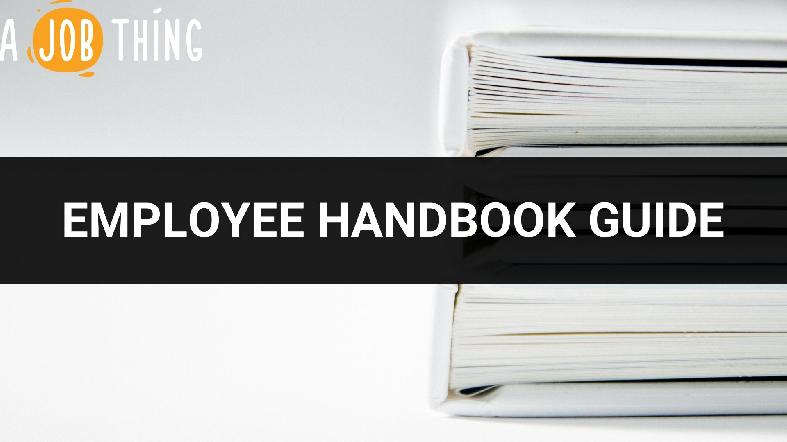
HR Guide: How to Write an Employee Handbook
Are You Hiring?
Find candidates in 72 Hours with 5+ million talents in Maukerja Malaysia & Ricebowl using Instant Job Ads.
HIRE NOW
When you're running a small business or an SME, you might not see the importance of having an employee notebook. But what you don't know is that once you start hiring more than a few employees, a handbook can be very valuable.
What's an Employee Handbook?
An employee handbook or manual is a document that tells your workers what to expect when they work for you. An employee handbook usually deals with practical information such as leave entitlement, benefits, and disciplinary procedures. It also lets your employees know what standards or work and behaviour you expect from them. It provides clarity on both sides.
An employee handbook is also perfect for introducing your new employees to the company by explaining your company's values and let them know who they can contact if they have problems.
There is no set format in writing an employee handbook, it's your document and you can choose how you want to communicate with your employees. But make sure the tone and format match your company's values.

It's essential to have an employee handbook when you're starting to hire more employees.
Why It's Good to Have an Employee Handbook
1. Helps with employee onboarding
A well-written employee handbook is perfect for helping new employees find their feet more quickly. Though they will probably not read the whole book from the start to finish, they can use it as a quick reference to get many of their questions answered easily.
2. Create better workplace policies
The key point of an employee handbook is to document everything a staff member needs to know to do their job. But what you may not know is that the act of documentation will help you to come up with better ways of doing things.
For example, when it comes to attendance, you might notice for some job functions, it does not matter if someone arrives late as long as they get the work done. This way, you can come up with a more flexible formula in your attendance policy.
3. Avoid constant questions about policies
HR knows a lot when it comes to employees having questions. These are some questions they're used to hearing:
- Which national holidays do we get paid for?
- What are the rules on conflicts of interest or working in other places?
- How many days do we have in our annual leave?
You can explain all of these in the employee handbook.
4. All-in-one
Usually, companies do have their policies documented but in a fragmented way. Some things are on the memo but others are only communicated through email. So it's hard for your workers to look up for specific information.
An employee handbook collects everything together into one place, so it's fast and easy to find information.
5. Avoid lawsuits
The basic purpose of the employee handbook is to set clear expectations on both sides. This clarity can also give you legal protection.
For instance, you had to dismiss one of your workers for poor attendance. The worker could try to sue you for unfair dismissal, claiming that it was never made clear to them that those things were grounds for being fired. If you have set out those policies in your handbook and documented the fact that all employees are given copies of it, then you have a stronger defence.

Make sure to make your employee handbook as clear as possible.
What You Must Have in an Employee Handbook
A. Company Overview
Employee handbooks usually start with an introduction and overview of the company. You can include a short history of your company, a timeline of key events, and a statement of important values and goals.
B. Safety policies
Your workers spend a lot of their time in the workplace, and the most important thing is their safety. In this section, you should tell what should be done in the event of an emergency or accident at work, how to access first aid, fire safety procedures, and so on.
C. Pay and benefits
This is where you explain when and how employees can expect to be paid, how tax and other deductions will be taken out, and whether they will be eligible for overtime. You should also include details on compensation and benefits such as benefits and dental insurance.
You can also include details of paid leave policies, such as parental leave, sick leave, annual leave, and so on.
D. Code of conduct
This is where you specify everything from dress code to the expected attendance level and punctuality. You can also include issues such as social media usage. Most companies prefer not to provide a list of rules that sounds punitive, and instead, giving general guidelines and leaving employees to use their discretion.
There are still some points where you need to be strict and clear in the employee handbook, such as the need to keep company data confidential.
E. Discipline and termination
Give your workers a clear idea of what constitutes grounds for disciplinary action and what kind of action will be taken. Let them know what they should do if they feel they have been treated unfairly. Next, you can set out the policy of what happens in the event of termination.
Remember that any disciplinary procedures you lay out here may be binding, so be careful about committing yourself to anything you don't want to follow in every single case. For instance, if you state in the employee handbook that you give a series of verbal and written warnings for disciplinary issues, you will get in trouble if you dismiss an employee without having given all those warnings.
Now that you've learned all about small business employee handbooks, you’re ready to begin writing an employee handbook for your own business.
Source: envato tuts+
Having Problems Hiring? Our recruitment experts are at your service, just register at AJobThing.com to schedule your free consultation.

